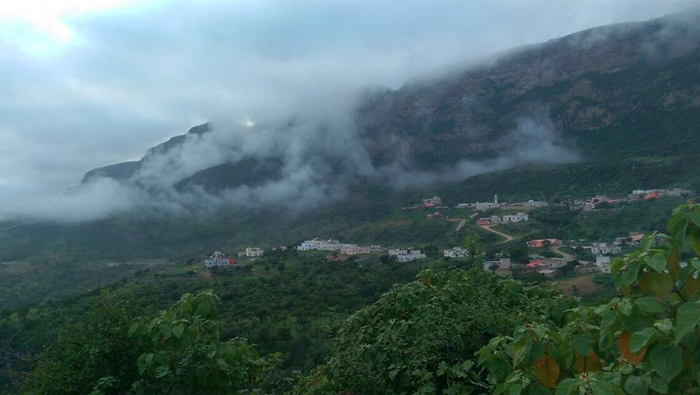
Dhalkut: During Khareef (monsoon season) the Sarfeet Mountains overlooking the village of Deem in the Wilayat of Dhalkut in the Governorate of Dhofar get a canopy of clouds.
Covered with mist, the mountains present a fascinating view that attracts many photographers and artists as well as other visitors.
Deem or as it is called by many residents “Ghudo Deem” is the last Omani village in the Wilayat of Dhalkut. It is one of the villages of Khadhrafi, which is adjacent to the borders of the sisterly Republic of Yemen. It is 150 kilometres from Salalah City.
Located on the road linking the Sultanate to the Republic of Yemen just about one kilometre from the border port of Sarfeet, Deem is distinguished by its unique strategic location, with beautiful views overlooking the Arabian Sea, making it a tourist destination for many visitors from inside and outside the Sultanate.
The villagers are known for their work in the field of trade and agriculture, especially livestock trade and their requirements for feed and grass. They breed camels, cows and goats and provide good care for them as they represent a source of income for the villagers.
“The villagers have different types of livestock, such as camels, cattle and goats. They are very interested in them because they represent a source of livelihood and trade for them,” said Sheikh Issa bin Tarshum Habis.
The villagers have a great interest in agriculture, especially seasonal agriculture during Khareef season where most of them cultivate various types of seasonal agricultural crops, mainly maize, and cowpea, known locally as “A’Dogur” where demand is growing at the end of December of each year. The value of one kilo is about OMR3. The crop of the village of Deem of corn or cowpea is characterised by large grain size, and free of agricultural pests and industrial fertilisers.
The village is surrounded by its beautiful pastures, the variety of its plants, and the natural mountain honey, which is the source of income for many honey breeders. They collect the honey from caves and valleys or from hives on the trees. The season of natural honey starts in October each year.
There are also many water springs, including (Deem, Thableel, Sarfeet, Qahood and Akoub). There are also many old archeological caves that were frequented in the past by the inhabitants to be protected from rain, wind and cold. These caves include (Dherbait, Howsam,Thrarout and Mana’arait). All are large in size that accommodate tens of families.
Many families still retain their old heritage houses made of logs and grasses, and are woven into a beautiful heritage that imitates the reality that the Omani citizen lived in. The houses are frequented by explorers, especially foreign tourists. Salim bin Ahmed Ra’afait, Deputy Wali of Dhalkut said, “Like all other villages and towns in the Sultanate, the village of ‘’Deem’’ has enjoyed a great deal of services during this auspicious era of His Majesty Sultan Qaboos bin Said, in various sectors, such as electricity, communications, education, health and transportation, where it is linked to all the neighbouring villages by paved roads. All internal roads were paved, water lines were supplied and internal lighting was provided to residential neighboruhoods and public streets”.
The Ministry of Education has also built a school with three floors for the students of the village and nearby communities. It is provided with all the necessary educational requirements.